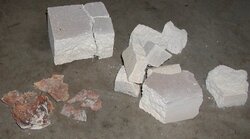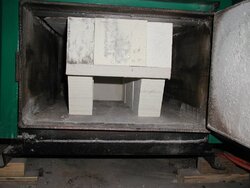I had an earlier thread on my attempts at a different combustion labyrinth for my EKO 25. While the design met the goals of faster startup, better heat transfer, and easier ash cleanout, my troubles are not yet over. An earlier inspection showed that the high-alumina lightweight refractory bricks were becoming high-alumina gravel. Also, the ceramic wool board that I use for the horizontal separator had melted where the flame hits directly under the nozzle.
I placed a thin sheet of titanium over the ceramic board to protect it, as earlier efforts with stainless steel and ceramic tile had been less than encouraging. Here's a photo of the titanium sheet after a few weeks:

Below is a picture showing the remains of one of the two firebricks that form the side of the top section as well as a photo of the whole assembly when it was new. The combustion happens in the top section, and the combustion gases then flow down and out towards the ash removal door. There, they flow out either side of the labyrinth and back along the sides to the back of the boiler.
Anyone out there with any refractory material suggestions?
I placed a thin sheet of titanium over the ceramic board to protect it, as earlier efforts with stainless steel and ceramic tile had been less than encouraging. Here's a photo of the titanium sheet after a few weeks:
Below is a picture showing the remains of one of the two firebricks that form the side of the top section as well as a photo of the whole assembly when it was new. The combustion happens in the top section, and the combustion gases then flow down and out towards the ash removal door. There, they flow out either side of the labyrinth and back along the sides to the back of the boiler.
Anyone out there with any refractory material suggestions?



